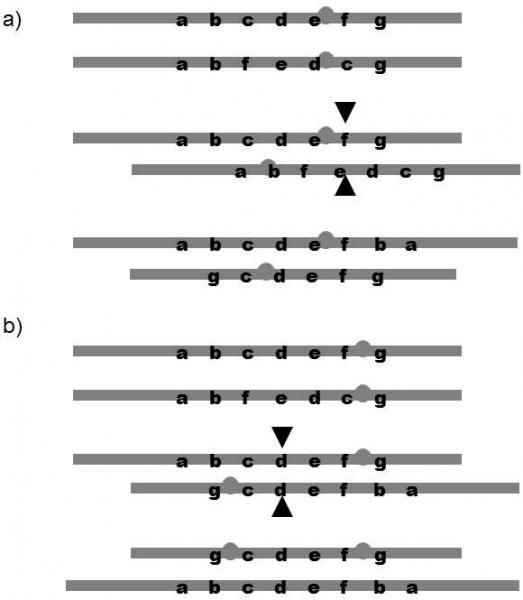III.5.3.1 Inversions can contribute to the formation of effective inter-species reproduction barriers
If DNA breakthat occur during chromosome mutation occur inside functional genes, these genes are mostly inactivated.However, this situation mostly does not occur in modern eucarycotic cells, as most of the DNA here does not represent functional genes.In some cases, this noncoding DNA probably fulfills a structural or regulation function.However, these are apparently frequently sections of selfish DNA, i.e. sections that are more readily duplicated than other sections because of their structure, so that they constantly spread in the genome of a certain species, without providing any benefit for their bearers.Although most restructuring does not lead to inactivation of a gene and is not manifested in the phenotype, translocations and inversions can be of great importance in speciation as one of the mechanisms of formation of interspecies barriers.If two individuals differing in the presence of a greater number of chromosomal mutations breed together, they have greatly reduced fertility.In recombination including the restructured DNA sections, frequent deletions occur of entire chromosome sections, so that many of these recombinants are not viable (Fig. III.3).

Fig. III.3. Occurrence of deletion, duplication and chromosome mutation as a consequence of recombination in the area of an inversion. If recombination occurs in the area of the inversion amongst homologous chromosomes differing only in the presence of an inversion, one of the recombined chromosomes will contain the duplicated section and the relevant section will, on the other hand, be missing on the second chromosome (a). If an inversion occurs in the area without the centromere, recombination could yield one chromosome with two centromeres and one chromosome without a centromere (b). These chromosomes cannot be properly transferred to the poles of the dividing spindle and cells containing these structures can thus not complete nuclear division.
For example, if two individuals differ in thepresence of paracentric inversion, i.e. inversion not including the centromere region, then recombination is prevented over entire long sections of the relevant chromosome or recombination leads to chromosomes without centromeres or with two centromeres, i.e. structures that reliably prevent nuclear division.
An increased frequency of inversion in some taxons could be the cause of an increased rate of speciation of these species and, as a consequence of the action of species selection (IV.8.4), also the cause of their evolutionary success (Trickett & Butlin 1994).
